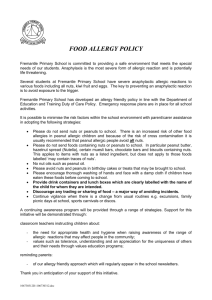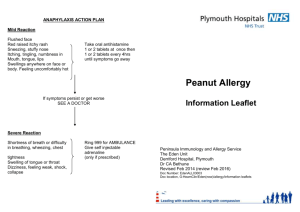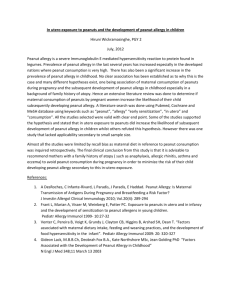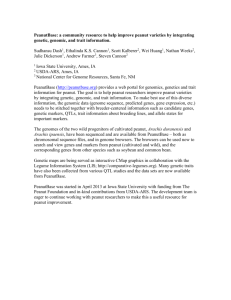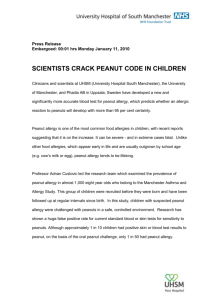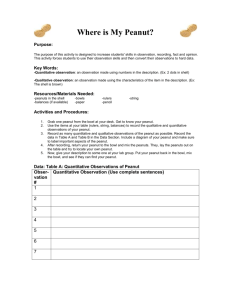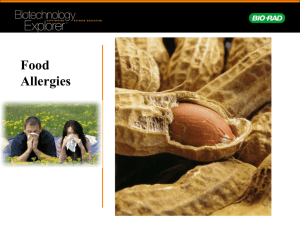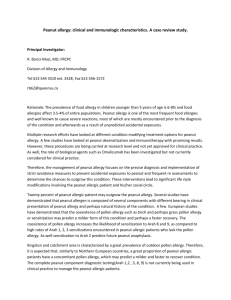Treatment - Amherst College
advertisement
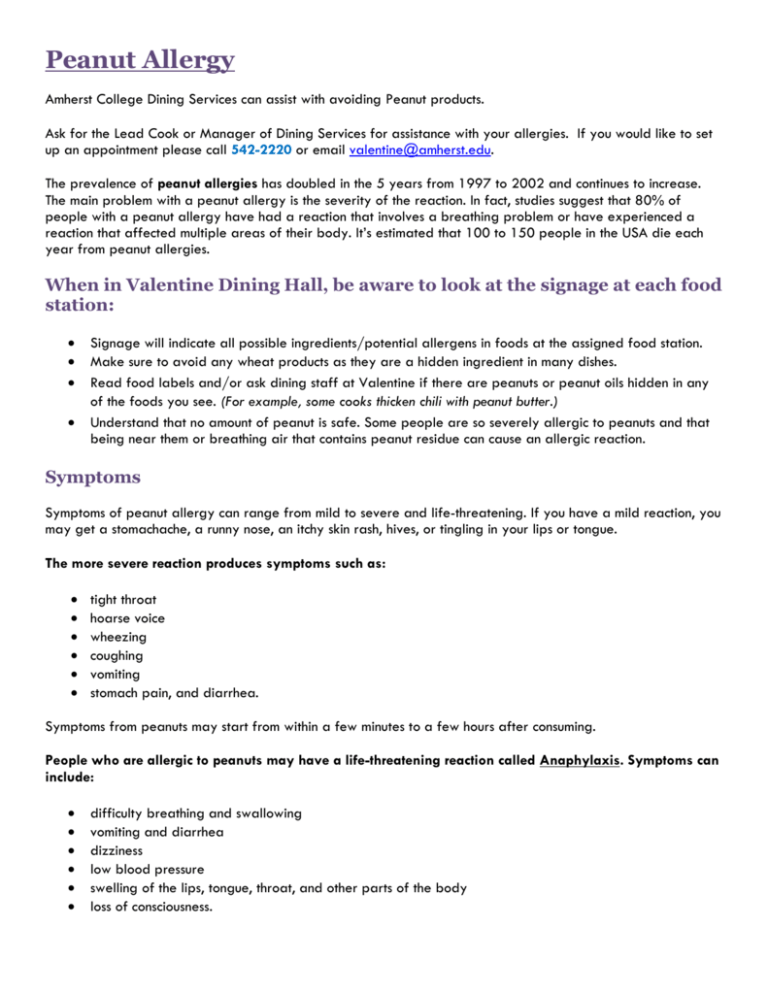
Peanut Allergy Amherst College Dining Services can assist with avoiding Peanut products. Ask for the Lead Cook or Manager of Dining Services for assistance with your allergies. If you would like to set up an appointment please call 542-2220 or email valentine@amherst.edu. The prevalence of peanut allergies has doubled in the 5 years from 1997 to 2002 and continues to increase. The main problem with a peanut allergy is the severity of the reaction. In fact, studies suggest that 80% of people with a peanut allergy have had a reaction that involves a breathing problem or have experienced a reaction that affected multiple areas of their body. It’s estimated that 100 to 150 people in the USA die each year from peanut allergies. When in Valentine Dining Hall, be aware to look at the signage at each food station: Signage will indicate all possible ingredients/potential allergens in foods at the assigned food station. Make sure to avoid any wheat products as they are a hidden ingredient in many dishes. Read food labels and/or ask dining staff at Valentine if there are peanuts or peanut oils hidden in any of the foods you see. (For example, some cooks thicken chili with peanut butter.) Understand that no amount of peanut is safe. Some people are so severely allergic to peanuts and that being near them or breathing air that contains peanut residue can cause an allergic reaction. Symptoms Symptoms of peanut allergy can range from mild to severe and life-threatening. If you have a mild reaction, you may get a stomachache, a runny nose, an itchy skin rash, hives, or tingling in your lips or tongue. The more severe reaction produces symptoms such as: tight throat hoarse voice wheezing coughing vomiting stomach pain, and diarrhea. Symptoms from peanuts may start from within a few minutes to a few hours after consuming. People who are allergic to peanuts may have a life-threatening reaction called Anaphylaxis. Symptoms can include: difficulty breathing and swallowing vomiting and diarrhea dizziness low blood pressure swelling of the lips, tongue, throat, and other parts of the body loss of consciousness. If not treated, death can result. Anaphylaxis usually occurs within minutes but can occur up to several hours after eating peanuts or peanut products. Foods to Avoid Here are some ingredients that you will want to stay away from to ensure safety from peanuts: Obviously anything that says NUTS.... Cookies and baked goods. Even if baked goods don't contain nut ingredients, it is possible that they came into contact with peanut or tree nuts through cross-contamination. Unless you know exactly what went into a food and where it was made, it's safest to avoid store-bought or bakery cookies and other baked goods. Candy. Candies made by small bakeries or manufacturers (or homemade candies) may contain nuts as a hidden ingredient. The safest plan is to eat only candies made by major manufacturers whose labels show they are safe. Ice cream. Unfortunately, cross-contamination is common in ice cream parlors because of shared scoops. It's also a possibility in soft-serve ice cream, custard, or yogurt places because the same dispensing machine is often used for lots of different flavors. Instead, do as you would for candy: Buy tubs of ice cream at the supermarket and be sure they're made by a large manufacturer and the labels indicate they're safe. Asian, African, and other cuisine. African and Asian (especially Thai and Indian) foods often contain peanuts or tree nuts. Mexican and Mediterranean foods may also use nuts, so the risk of crosscontamination is high with these foods. Sauces. Many cooks use peanuts or peanut butter to thicken chili and other sauces. Always proceed with caution even if you are used to eating a particular food. Even if you've eaten a food in the past, manufacturers sometimes change their processes — for example, switching suppliers to a company that uses shared equipment. And two foods that seem the same might also have differences in their manufacturing. Here are some other precautions you can take: Be on the watch for cross-contamination that can happen on kitchen surfaces and utensils — everything from knives and cutting boards to the toaster. Make sure the knife another family member used to make peanut butter sandwiches is not used to butter your bread and that nut breads are not toasted in the same toaster you use. You may decide to make your home entirely nut-free. Avoid cooked foods you didn't make yourself — anything with an unknown list of ingredients. Tell everyone who handles the food you eat, from relatives to restaurant waitstaff, that you have a nut allergy. If the manager or owner of a restaurant is uncomfortable about your request for peanut- or nutfree food preparation, don't eat there. Make school lunches and snacks at home where you can control the preparation. Be sure your school knows about your allergy and has an action plan in place for you. Keep rescue medications (such as epinephrine) accessible at all times — not in your locker, but in a pocket, purse, or bookbag that's with you. Seconds count during an episode of anaphylaxis. Your allergist should be able to provide you with a complete listing of ingredients that may indicate peanut protein. There are always new products being created with newly processed ingredient names. If you don’t know the exact nature of the ingredient, don’t eat it! Treatment If you think you are having an allergic reaction: If you accidentally eat a peanut, follow your doctor's instructions. For a severe allergic reaction: Call the Amherst College Campus Police at 413-542-2111 or ext 2111. If you have medical concerns about this or any other allergy, please contact Amherst College Health Services.


